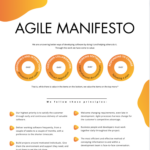[ Agile Manifesto — Principle 5 ]
The fifth principle of the Agile Manifesto underscores the belief that motivated individuals are at the heart of successful projects.
But what exactly makes an individual or team motivated? How can an organization create an ideal environment to foster such motivation? And, more critically, how do you build a project around these motivated individuals when traditional methodologies often do the opposite — selecting people after the project is defined? In this article, we will explore these questions and delve into how companies like Netflix have successfully implemented these ideas. And read what happened to Nokia when thei failed to trust their poeple…
What Makes a Motivated Individual or Team?
Intrinsic vs. Extrinsic Motivation
Motivation comes in two main flavors: intrinsic and extrinsic:
Intrinsic motivation is all about personal satisfaction and the joy of doing the task itself. Extrinsic motivation, on the other hand, is driven by external factors like rewards, recognition, and compensation.
In Agile software development, intrinsic motivation is particularly valuable and important. Intrinsically motivated individuals tend to exhibit greater creativity, engagement, and resilience. They find fulfillment in the work itself, leading to sustained productivity and a proactive approach to problem-solving. And whether we work in an agile way or not, we can all relate to this. When we WANT to achieve something, we automatically put more passion (love, energy, thought,…) into the task at hand.
While intrinsic motivation is crucial, extrinsic motivation also plays a significant role. Rewards, recognition, and compensation can serve as important incentives, particularly when aligned with intrinsic motivators. Extrinsic rewards can help maintain motivation, especially during challenging periods or when intrinsic motivation alone might wane.
We need both extrinsic and intrinsic motivation
For an organization, the ideal approach is to balance both intrinsic and extrinsic motivation. Relying solely on extrinsic motivators, like paying high salaries, can lead to compliance rather than genuine engagement. On the other hand, focusing exclusively on intrinsic motivators might not provide the tangible rewards some employees need. By combining both, organizations can create a comprehensive motivational strategy that supports sustained performance and job satisfaction.
Scrum value of “commitment” and motivation
One thing I have to mention here is the Scrum value of “commitment” as this causes a lot of misinterpretation. Managers want their teams to commit. And they want their employees to commit to a certain amount of work to be dealt with during the next Sprint.
However, what we really would be after is to create a motivation for team members to wanting to achieve the Sprint goal and to deliver high-quality work. This value is inherently linked to intrinsic motivation, as committed individuals are driven by a sense of purpose and ownership over their work. Having said that, I think that any commitment forced upon teams is worthless.
Key factors of motivation
Since you cannot force someone to be motivated, what can you do to enable and keep motivation high for your employees?

In his seminal book “Drive,” Daniel Pink identifies three primary drivers of motivation: Autonomy, Mastery, and Purpose. By incorporating these elements into their culture and practices, organizations can create an environment where motivated individuals thrive, leading to greater innovation, productivity, and overall success.
Autonomy
According to Pink, autonomy is the urge to direct our own lives. Organizations can achieve this by giving employees the freedom to choose how they accomplish their work. This can be facilitated through flexible work hours, remote work options, and empowering teams to make decisions.
As Pink states,
“Control leads to compliance; autonomy leads to engagement.”
Mastery
Pink describes mastery as the desire to continually improve at something that matters. Organizations can support mastery by offering continuous learning opportunities, such as training programs, workshops, and mentorship. Additionally, setting challenging yet achievable goals encourages employees to develop their skills. A focus on mastery ensures that employees remain engaged and invested in their personal growth and performance.
Purpose
Purpose is about connecting to a cause larger than oneself. Organizations can instill a sense of purpose by clearly communicating their mission and how each employee’s work contributes to it. This can be achieved through regular updates, town hall meetings, and storytelling that highlights the impact of the team’s efforts. Pink argues:
“The most deeply motivated people…hitch their desires to a cause larger than themselves.”
Recognition and Feedback
While not explicitly covered in “Drive,” recognition and feedback are critical for motivation. Regular, constructive feedback helps employees understand their strengths and areas for improvement. Recognition programs, whether through formal awards or informal praise, reinforce positive behaviors and show appreciation for hard work. Organizations can implement structured feedback cycles, peer recognition programs, and celebrate achievements to maintain high levels of motivation and engagement.
The Ideal Environment
An ideal environment for motivated individuals includes several key elements that foster creativity, collaboration, and continuous improvement.
Psychological safety is crucial. A psychologically safe environment encourages individuals to take risks, voice their opinions, and make mistakes without fear of criticism or retribution. This openness fosters creativity and innovation.
Additionally, promoting collaboration over competition ensures that team members support each other and work towards common goals. Practices like daily stand-ups (done right!), pair programming, and collaborative decision-making enhance teamwork.
Continuous learning and development opportunities are vital. Providing training, workshops, and real-world challenges help individuals grow and stay motivated.
Lastly, a clear vision and objectives are necessary. A well-communicated vision aligns the team’s efforts with the organization’s strategic goals. When individuals understand how their work contributes to the bigger picture, it enhances their sense of purpose and motivation.
Building Projects Around Motivated Individuals
Huh? Isn’t it the other way round usually? Yes, the traditional approach involves defining a project and then assembling a team to execute it. However, the Agile principle advocates the opposite: starting with a motivated team and building the project around them. This shift can be achieved through several practices:
- Forming cross-functional teams. This structure reduces dependencies and enables the team to work more autonomously.
- Empowering teams with decision-making authority to foster a sense of ownership and accountability. This autonomy enables teams to respond quickly to changes and make adjustments without bureaucratic delays.
- An iterative and incremental approach to project management helps. Delivering value in small, manageable increments keeps the team motivated by showcasing regular achievements and provides frequent opportunities for feedback and course correction.

As Peter Drucker said, “The best way to predict the future is to create it.” By building projects around motivated individuals, organizations create an environment where innovation and success can thrive.
Establishing Trust
Trust is the foundation of any effective team. Building trust requires consistency, transparency, and communication. It sounds so easy, but most organizations I have seen don’t live up to this. To be fair, many leaders and managers have trust issues and don’t live up to this.
Earn and reinforce trust by being open and reliable. When you consistently meet your commitments and take responsibility for your actions, trust naturally develops.
Leaders who support their teams, provide the necessary resources, and remove obstacles help build trust. This support enables teams to focus on their work and feel confident that their leaders have their back.
Examples of Trust and Motivation in Action (and Inaction)
I want to explore the real companies and how they succeeded or failed with embracing the 5th principle:

Netflix
Netflix is renowned for its unique culture emphasizing freedom and responsibility. They hire top talent and give them the autonomy to innovate and make decisions. Their culture deck outlines principles like avoiding rules that impede creativity and allowing employees to make decisions without multiple levels of approval. This environment of trust and empowerment has driven Netflix’s innovation and success.
Netflix’s approach shows the power of building projects around motivated individuals. By creating an environment of freedom, responsibility, and trust, Netflix fosters a culture of innovation and high performance. Attracting and retaining top talent, along with providing a supportive environment, exemplifies the fifth Agile principle. Netflix’s model serves as a valuable example for other organizations looking to harness motivated individuals to drive success and innovation.
Hiring Top Talent & the “Keeper Test”
Netflix prioritizes hiring top talent, investing in individuals who are highly skilled, intrinsically motivated, and aligned with Netflix’s values. This ensures projects are built around driven individuals capable of working autonomously. Netflix uses the “Keeper Test,” where managers ask if they would fight to keep an employee considering leaving. This ensures the team is composed of highly motivated individuals committed to the company’s success. Continuous feedback and recognition are also emphasized to maintain motivation. Candid feedback helps individuals improve and stay engaged, while recognizing accomplishments reinforces the value of contributions.
A Culture of Freedom and Responsibility
Netflix’s culture of “freedom and responsibility” is key to fostering a motivated workforce. This philosophy believes that talented individuals perform best with the freedom to make decisions and the responsibility to deliver results. Their widely shared culture deck encapsulates this approach, serving as a blueprint for the company.
Autonomy in Decision-Making
At Netflix, employees are empowered to make decisions independently, which fosters motivation and engagement. The company has minimal formal policies, encouraging employees to use their judgment and make decisions. This trust and empowerment allow teams to respond swiftly to changes and challenges, fostering innovation.
One example is Netflix’s approach to content creation. They trust creative teams to develop original content without extensive oversight, leading to groundbreaking shows like “Stranger Things” and “The Crown.” These successes came from motivated teams given the freedom to explore their ideas.
Another example is Netflix’s approach to technology. Engineers are encouraged to experiment and innovate, leading to advancements in streaming technology and user experience. The development of Netflix’s recommendation algorithm was driven by autonomous teams focused on enhancing user satisfaction.
A Supportive Environment
Netflix provides the support employees need to succeed, including cutting-edge technology and industry-leading tools. The company also promotes a healthy work-life balance, understanding that personal well-being is crucial for maintaining motivation and performance.

Google is a prime example of an organization that builds projects around motivated individuals.
The “20% Time” policy & Innovation
The company’s famous “20% time” policy lets employees spend 20% of their workweek on projects they’re passionate about, even if they’re outside their primary job responsibilities. This has led to successful products like GMail and Google News, demonstrating how intrinsic motivation drives breakthrough innovations. By trusting employees to explore their interests, Google cultivates a highly motivated and creative workforce.
Google’s approach to innovation shines in projects like the Android operating system and AI initiatives. Android, which started as an internal project, is now the most widely used mobile OS.
Hiring for Motivation and Skill
Google’s rigorous hiring process attracts individuals who are not only highly skilled but also intrinsically motivated. The company seeks candidates passionate about problem-solving and committed to continuous learning, ensuring projects are staffed by naturally driven individuals aligned with Google’s mission.
Performance reviews are comprehensive and developmental, helping employees understand their strengths and areas for improvement. Google offers numerous opportunities for growth, including training programs, workshops, and access to industry experts, keeping employees motivated and engaged.
“One of the things we’ve seen at Google is that if you give people freedom, they will amaze you.” — Laszlo Bock, former Senior Vice President of People Operations at Google
Innovation and Autonomy
Google’s culture is built on innovation and autonomy. The belief that motivated individuals drive progress is evident in their operations. Google empowers its employees by encouraging decision-making and ownership of their work. Teams can explore new ideas and experiment without needing extensive approvals, fostering a culture of trust and initiative.
A Supportive Environment
Google knows a supportive environment is crucial for motivation. They provide state-of-the-art facilities, ergonomic workspaces, and amenities like free meals and on-site fitness centers. Flexible work schedules and generous leave policies promote a healthy work-life balance. By taking care of their well-being, Google keeps employees motivated and productive.

Nokia
Nokia’s story. You might think: Yeah, when you are a big player and have tons of money, it is easy to create such an environment. But it is not. Nokia’s decline from its position as the world’s leading mobile phone manufacturer provides a striking example of what can happen when a company fails to live up to the fifth principle of the Agile Manifesto.
In the late 1990s and early 2000s, Nokia was a dominant force in the mobile phone industry. The company was known for its innovation, robust product design, and widespread market presence. However, by the early 2010s, Nokia’s market share had plummeted, and in 2013, it sold its mobile phone business to Microsoft. Several factors contributed to Nokia’s downfall, but a critical issue was its failure to build projects around motivated individuals and provide them with the environment and support they needed.
Failure to Foster Autonomy and Innovation
Nokia’s management structure became increasingly bureaucratic and hierarchical over time. This stifled the autonomy and creativity of its employees. Instead of empowering teams to innovate and make decisions independently, the company imposed rigid processes and extensive approval hierarchies. This environment made it difficult for motivated individuals to drive change and develop new ideas swiftly and hindered Nokia’s ability to respond to market changes and technological advancements.
Lack of Support for Intrinsic Motivation
Nokia’s internal culture also suffered from a lack of support for intrinsic motivation. Employees felt that their contributions were undervalued, and there was little emphasis on personal growth and mastery. In an industry driven by rapid innovation, the absence of continuous learning and development opportunities can demotivate even the most talented individuals.
Nokia’s failure to prioritize this aspect contributed to a demotivated workforce and an inability to keep pace with competitors.
Ignoring Market Signals and Employee Input
Nokia’s management was often slow to react to changing market conditions and emerging technologies. Despite warnings from engineers and other employees about the potential of new platforms like iOS and Android, Nokia’s leadership clung to its existing strategies and technologies. This top-down decision-making process ignored the insights and recommendations of motivated individuals who were closer to the technological and market developments.
By not trusting and empowering its employees to make critical decisions, Nokia missed key opportunities to pivot and innovate.
Stephen Elop, former CEO of Nokia, in his “Burning Platform” memo:
“We have lacked accountability and leadership to align and direct the company through these disruptive times. We had a series of misses. We haven’t been delivering innovation fast enough. We’re not collaborating internally.”
The Symbian Platform Debacle
One of the most significant failures was Nokia’s insistence on continuing with the Symbian operating system while the market was shifting towards more user-friendly and versatile platforms like iOS and Android. Engineers within the company recognized the limitations of Symbian and the need to move towards more modern operating systems. However, their concerns were not adequately addressed by management, leading to a disconnect between the company’s strategic direction and the market’s needs.
Having worked with Symbian OS myself, I can tell you, it was beyond painful! Someone had to come up with something more developer-friendly sooner than later …
Conclusion
Nokia’s decline serves as a cautionary tale about the importance of adhering to the fifth Agile principle and their back-then claim “Connecting People.”. The lesson from Nokia’s experience is clear: nurturing a motivated and empowered workforce is not just a desirable aspect of company culture but a critical component of sustainable success and innovation.
Building the Ideal Environment: Practical Steps
What can you do in your company to create an environment where employee motivation and innovation can flourish?
- Recruitment and Onboarding:
Focus on hiring individuals who align with the company’s values and demonstrate intrinsic motivation. During onboarding, emphasize the organization’s culture of trust, autonomy, and continuous improvement.
Example: Atlassian incorporates values-based interview questions to ensure candidates align with their core principles of openness and collaboration. During onboarding, new hires participate in an intensive boot camp where they learn about the company’s Agile practices and culture of trust.
- Creating a Safe Space:
Foster a culture where feedback is encouraged and mistakes are viewed as learning opportunities. This can be achieved through regular retrospectives and a non-punitive approach to failure.
Example: At Pixar, teams hold “Braintrust” meetings where honest feedback is shared in a supportive environment. This practice encourages creativity and innovation by treating failures as opportunities for growth rather than setbacks.
- Empowering Teams:
Provide teams with the autonomy to make decisions and control their work processes. Implement tools and practices that support self-organization.
Example: Spotify used “squads” that operate like mini-startups with the autonomy to make decisions and manage their work.
- Continuous Feedback and Recognition:
Implement a system for regular feedback and recognition. This can include peer reviews, one-on-one meetings, and public acknowledgment of achievements.
Example: Google employs a continuous feedback system through its “Googlegeist” employee survey and peer reviews. Additionally, they have an internal recognition program called “gThanks” where employees can publicly acknowledge each other’s contributions.
- Professional Development:
Offer opportunities for continuous learning and professional growth. This could include training programs, workshops, conferences, and mentorship.
Example: LinkedIn provides its employees with access to LinkedIn Learning, an extensive online library of courses. They also sponsor attendance at industry conferences and have a formal mentorship program to support professional growth.
- Clear Objectives and Vision:
Ensure that the organization’s vision and goals are clearly communicated and understood by all team members. Use OKRs (Objectives and Key Results) to align individual and team goals with the organization’s strategic objectives.
Example: Intel pioneered the use of OKRs (Objectives and Key Results) to align their team’s efforts with the company’s strategic goals. This approach has been adopted by many leading tech companies, to ensure that every team member understands how their work contributes to the broader mission.
Summary
Motivation in the workplace can be intrinsic, driven by personal satisfaction, or extrinsic, influenced by rewards and recognition. In Agile development, intrinsic motivation is crucial, as it fosters creativity, engagement, and resilience. However, a balance of both types is ideal for sustained performance and job satisfaction.
Key drivers of motivation include:
- Autonomy: Allowing employees to direct their work.
- Mastery: Encouraging continuous improvement through learning opportunities.
- Purpose: Connecting work to a larger mission.
Recognition and feedback also play vital roles in maintaining motivation.
Successful companies like Netflix and Google exemplify these principles:
- Netflix: Emphasizes freedom and responsibility, empowering top talent with autonomy and continuous feedback.
- Google: Uses the “20% time” policy to foster innovation and hires intrinsically motivated individuals.
Conversely, Nokia’s decline underscores the dangers of stifling autonomy and failing to support intrinsic motivation, highlighting the importance of building projects around motivated individuals for sustained success.
We are here to coach you and your team. We’ve got a range of awesome trainings for you to pick from.
THE poster to always have the Agile Manifesto right in front of you. Or simply, to visually enhance a dull workplace.





